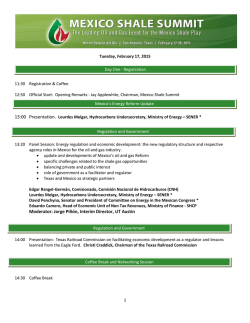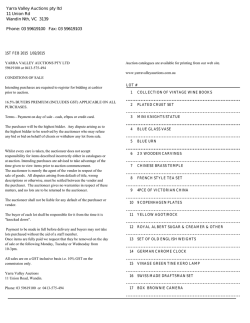
Outline Curriculum Plan Years 5 and 6
Long Term Plan Years 5 and 6 2014 ‐ 2015 THEME AUTUMN A Awesome Aztecs AUTUMN B Awesome Aztecs SPRING A SPRING B SUMMER A SUMMER B Stone Age Living things and Habitats ( Y5 unit) Children describe the differences in the life cycles of a mammal, an amphibian, an insect and a bird. ...describe the life process of reproduction in some plants and animals. Victorious Victorians Trip. Light Children recognise that light appears to travel in straight lines ...use the idea that light travels in straight lines to explain that objects are seen because they give out or reflect light into the eye ...explain that we see things because light travels from light sources to our eyes or from light sources to objects and then to our eyes ...use the idea that light travels in straight lines to explain why shadows have the same shape as the objects that cast them. Victorious Victorians Electricity Children associate the brightness of a lamp or the volume of a buzzer with the number and voltage of cells used in the circuit. They compare and give reasons for variations in how components function, including the brightness of bulbs, the loudness of buzzers and the on/off position of switches. Children use recognised symbols when representing a simple circuit in a diagram. SCIENCE Earth, Space and the Water Cycle Children will describe the movement of the Earth, and other planets, relative to the Sun in the solar system, the movement of the Moon relative to the Earth. They will describe the Sun, Earth and Moon as approximately spherical bodies and use the idea of the Earth’s rotation to explain day and night and the apparent movement of the sun across the sky. Animals including Humans Children identify and name the main parts of the human circulatory system, and describe the functions of the heart, blood vessels and blood ...recognise the impact of diet, exercise, drugs and lifestyle on the way their bodies function ...describe the ways in which nutrients and water are transported within animals, including humans. Pupils will learn how to keep their bodies healthy and how their bodies might be damaged – including how some drugs and other substances can be harmful to the human body. Evolution and Inheritance Children recognise that living things have changed over time and that fossils provide information about living things that inhabited the Earth millions of years ago ... recognise that living things produce offspring of the same kind, but normally offspring vary and are not identical to their parents ...identify how animals and plants are adapted to suit their environment in different ways and that adaptation may lead to evolution. I.C.T History link. Children will plan an algorithm for a quiz game, breaking it up into the parts required to make a game. Program the game using variables to add a score to the game/timing for the game. Continue to test the game while making it and correct any errors in the programming and any errors in the algorithm used for the game. Children select computing software to create a simulation and explore to get screen elements to interact with the mouse. They plan and prepare an interactive model of a system in the human body and program multiple parts of the model to give explanations of the system. Explore the online programming community to identify how this can help with both developing a program and sharing it with others. Science link. Children have the opportunity to remind themselves of the basics of logo programming through exploration of FMS Logo and, as they gain confidence, extend their knowledge to more complex commands. Children create repeat procedures including the use of an ‘if’ statement to stop a procedure. They develop and improve algorithms which they program in Logo software. they explore ways in which Logo can use number operations and continue to debug their programs. Finally, children use Logo to make function machines. Science link. Decompose a problem into smaller parts to design an algorithm for a specific outcome and use this to write a program. Recognise similarities to solutions used before Explain and program each of the steps in my algorithm Change an input to a program to achieve a different output. Use different inputs (including sensors) to control a device or onscreen action and predict what will happen Refine a procedure using repeat commands to improve a program. Talk about how a computer model can provide information about a physical system. Use logical reasoning to detect and debug mistakes in a program and in my algorithm. Long Term Plan Years 5 and 6 2014 ‐ 2015 AUTUMN A Topic History/ Literacy GEOG RAPHY ART AUTUMN B Awesome Aztecs Who were the Aztecs and when did they live? Finding out who the Aztecs were and how they built their empire, placing the Aztecs on a timeline of world history. How was Aztec society organised? Explore the roles of emperors, nobles, warriors, priests, farmers and other people in Aztec society and how families were organised into calpullis.How did the Aztecs build the city of Tenochtitlan? Investigating how they changed a swampy island in Lake Texcoco into a thriving city through the use of aqueducts, causeways, chinampas and canals.What did the Aztecs believe and how did this impact on their lives? Learn about the Aztec belief that all life was governed by a multitude of gods; investigate the Aztec practice of human sacrifice and the reasons behind it. What was daily life for the Aztecs? Research what daily life was like for the Aztecs in terms of homes, clothes, schools, markets and food. How and why did the Aztec empire end? Learn about Cortès, the conquistadors and their invasion of Mesoamerica, explore the chain of events that led to the downfall of the Aztecs. Think about the different views that the different sides held about what happened. Contrast with British history. Where did the Aztecs live? Children Locate Mesoamerica and Mexico on a world map, identifying the continents of North and South America, exploring a map of Mexico to find Mexico City and what was Tenochtitlan. What is Mexico like? Explore the geographical features of Mexico, such as size, population, landscape, and climate. Mini HW project on modern Mexico. Using data and information to answer questions about the geographical features of Mexico. What would a holiday in Mexico be like? Explore reasons why Mexico is a popular holiday destination, finding out about specific activities and locations tourists can visit in Mexico. Children develop their knowledge Children design and use imaginative of texture, colour and textiles techniques and materials to express including needle craft by creating own ideas and feelings to create a an accessory using Aztec mosaic calendar and key holder. weaving. SPRING A SPRING B The Stone Age Children research the Stone Age, become familiar with how they lived and understand the major prehistoric human achievements SUMMER A SUMMER B Victorious Victorians Children develop a chronologically secure knowledge of British history through learning about the Victorians. They devise questions about change, cause similarity and difference and compare this with other times studied. Children will learn about Charles Dickens, Oliver Twist (Older literature), plays, poetry (Longfellow, Tennyson,Browning) and biographies e.g. Queen Victoria. This unit will also link to maths – dealing with historical data, the census, the Victorian larder, converting metric/imperial. Cave paintings Children use a variety of mark‐making techniques to interpret the texture of a surface. Work collaboratively on a larger scale. Explore using layers of colour and materials. Create mood. Geography skills TBC Compare and contrast modern day of Upper Arley to Victorian times. Use field work to measure, record and present the human and physical features in Upper Arley including sketch maps, plans, graphs and digital technologies. Children will develop their art skills through exploring portraits, miniatures and camaras. Victorian artists. Puppet making (punch and Judy literacy link) and designing and making a Victorian toy. Mrs Beaton cooking – using and converting recipes from the Long Term Plan Years 5 and 6 2014 ‐ 2015 DT P.E. Dance Children will create, perform and watch and evaluate a dance based on The Aztecs which will involve individual, partner and group work. Invasion Games: Kidderminster Harriers. Children develop the range and quality of their skills when playing football. They also learn specific tactics and skills. This is also linked with Healthy Lifestyles. Food Technology. Link with Science. Children learn about food groups, design a recipe card to promote healthy recipes, research foods from around the world and plan, produce and make their own recipe, adapting it as necessary. Gymnastics ( Wolverley): Children will learn how to use variations in speed, level and direction, how to combine and link actions, how to relate to partners and apparatus, to develop sequences that show an awareness of their audience. Invasion Games Rugby Children develop the range and quality of their skills when playing tag rugby. They also learn specific tactics and skills such as attack and defence. (Hockey was completed instead) Dance Children will create, perform and watch and evaluate a dance based on Dance TOP cards which will involve individual, partner and group work. Invasion Games Hockey Children develop the range and quality of their skills when playing hockey. They also learn specific tactics and skills such as attack and defence. MFL RE Sports and Hobbies Stating preferences. Revision of questions, sentence structure, intonation etc. Je fais Je joue Introduce infinitives of verbs. Popular sports in France French football teams and players (H/W project). (Chez moi – unit 7 (je m’amuse) Chez moi – unit 11 (le weekend) YEAR 5 MODULE 2) Christianity and Islam Children will learn key Christian and Muslim beliefs and practices. Initially focussing on the places of worship. Children will compare and also Christmas (Telling the Time) Ourselves Time vocabulary – routines? Present simple ‐ I go. I wake etc Describing what we and others look like Use of adjectives – agreeing genders where appropriate. (Y5 module 5) Children will learn about Christmas in different francophonic countries. (Y5 module 7 – Time) Children will focus on question :‐ How does giving zakah in a mosque strengthen the Muslim community? Trip to a mosque. What can we learn about the ummah from a visit to a mosque? How are Christian and Christianity and Islam What is the Qur’an and why is it important to Muslims? Why is Muhammad important to Muslims? Compare these questions Appraising, planning, designing and making own Victorian dolls house. Victorian age. Athletics Children will develop the skills of running, jumping, throwing and catching in isolation and in combination. They develop flexibility, strength, technique, control and balance. Net/Wall Games Tennis Children will develop their hitting, target, hand‐eye coordination and strategy skills. Athletics Children will develop the skills of running, jumping, throwing and catching in isolation and in combination. They develop flexibility, strength, technique, control and balance. Net/wall Games Rounders and Cricket Children will develop their hand eye‐co‐ordination skills, attacking and fielding skills and develop their game play skills. Shopping/French towns Children will learn about French towns. Il ya Je vais au Introducing future tense. (Ici et la – unit 1 (bienvenue) Unit 3 )ou vas tu?) YEAR 6 MODULE 2) Eating out French cafes and food. Vouz desirez quelque chose? Je voudrais. (Y5 module 10) Children plan their own French cafe for the rest of the school to attend. How is the life of Jesus relevant today? What do the stories tell us? Link with Muhammad. Why do Christians remember particularly Christianity and Islam Children will learn and investigate key questions. How does giving to charity help our neighbours? Children review what they have learnt about Christianity and Islam. OAA Children will experience co‐operation activities and this will lead up to orienteering activities using the school grounds. Invasion Games Netball/Basketball Children develop the range and quality of their skills when playing netball/basketball. They also learn specific tactics and skills such as attack and defence. What rules do Christians and Muslims follow? Long Term Plan Years 5 and 6 2014 ‐ 2015 PSCHE compare the use of prayer in the 2 faiths and the different dimensions of prayer. Muslim places of worship similar? How are they different? with Christianity. Jesus at Easter? New Beginnings Getting to know each other • Rights and responsibilities • The class charter • Creating a community • Joining a new group • Feeling welcome and welcoming others • Belonging • Gifts and Talents Getting on and falling out & Say no to bullying Issues will be addressed as they arise. MUSIC Journey into space (science link) Children will extend their sound vocabulary, including the use of ICT, and they will compose a soundscape. Aztec music ‐ Children listen and respond to Aztec music. They create their own compositions in groups using different rhythm patterns. Children will listen to different pieces of music at the start of each lesson to encourage use of listening skills, interpretation and imagination. Co‐operation • Friendship and working together • Understanding and managing feelings • Conflict resolution and problem solving • Active listening • Making and sustaining friendships • Seeing things from another point of view • (What is bullying? (key messages, witnesses/ bystanders, the bully and the bullied) • Creating a safe school • Becoming a ‘telling’ school. Singing in a round/unison Christmas Children will perform a round in two or more parts and identify how the parts fit together. They will describe the effect of different combinations of pitched notes using the terms; tense, tight, relaxed, loose and comfortable. Children will sing a round with confidence and accompany their singing with a repeated chord. Children will practise their own parts and rehearse with others, showing that they know how to contribute appropriately to the overall effect . They will improve their performance through listening, internalising and analysing (in their own minds) what changes need to be made. They will achieve a quality performance. The children will develop the ability to sing and play music in two parts. They explore harmony and experiment with clusters of pitched notes, discovering concords and discords. They will sing in rounds and experiment with melodramatic ostinati. They will play drones and single note accompaniments. Some of the work will link to the Stone Age Topic. Issues will be addressed as they arise. Transition to the next year group. Transition to the next year group. Y5 and 6 Sex Education Use of the film Oliver to stimulate song writing. Develop understanding of the history of music, composers, composition, organisation and manipulation of ideas. End of Year Performance. Long Term Plan Years 5 and 6 2014 ‐ 2015 To investigate where radiators are used in school and how many reflective panels would be needed to reflect heat energy back into the room. To calculate the potential savings of using reflector panels in classrooms. Links to KS2: Mathematics. ECO To explore food chains in a freshwater habitat and discover the effects of pollution within a food chain. Lesson 15 KS2 Pollution Game To undertake a survey of your neighbourhood over a period of time and make proposals for improvements in the street layout.
© Copyright 2026




